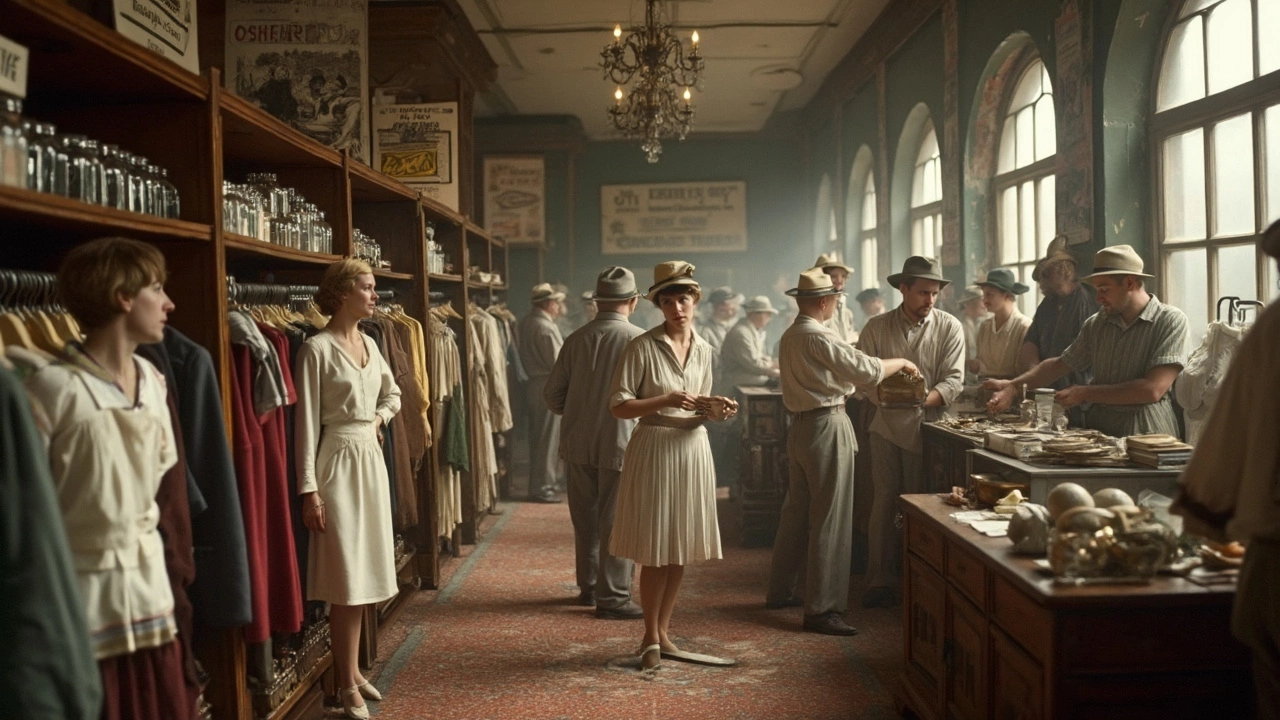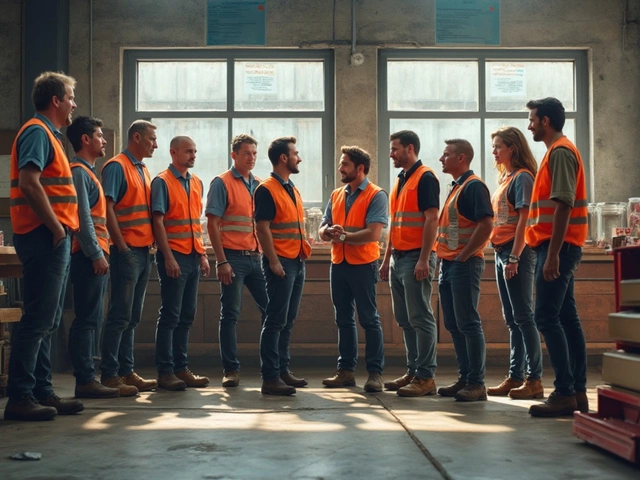The Origin of American Sportswear: How It All Began

- Cleo Fairchild
- 3 March 2025
- 0 Comments
Did you know that American sportswear wasn't always about style and trends? It actually kicked off with practicality at the heart of its design. Back in the early 1900s, as people began seeking comfortable and functional clothing for leisure activities, the concept of sportswear started to gain traction. The idea was simple—clothes that allowed freedom of movement and catered to the increasingly active lifestyle of Americans.
One pivotal moment was the introduction of practical garments like the shirtwaist, a blouse/skirt combo that became a go-to for many women. And then there was the emergence of menswear-inspired pieces that blurred the lines between formal and casual. These early innovations laid the groundwork for what would become a multimillion-dollar industry.
- Early 20th Century Beginnings
- Key Pioneers in Sportswear
- Iconic Sportswear Pieces
- The Role of Mass Production
- Influence of American Culture
- Global Impact and Future
Early 20th Century Beginnings
So how did American sportswear spring to life? It was a mix of necessity and a shift in society's pace. At the beginning of the 20th century, Americans started engaging more in recreational activities. The demand was crystal clear—people wanted clothes that let them move freely and yet look presentable.
Advent of Functional Fashion
Women's fashion took a significant turn with the introduction of the shirtwaist. This practical mix of a blouse and a skirt offered women a convenient and stylish option as they embraced work outside the home and other social hobbies. In fact, it marked one of the first instances where style met functionality head-on.
The Rise of Ready-to-Wear
Prior to this, most clothing was custom-made. But by the 1920s, the ready-to-wear industry was booming, thanks to mass production techniques. Clothing became more accessible to the everyday consumer, paving the way for expanded wardrobes and diverse styles.
Influence of Sports
There was also a growing interest in sports during this era. Tennis and golf became hugely popular pastimes, and with them came the need for specialized attire. Designers responded by creating comfortable, fashionable clothes that moved with the body, setting the stage for modern sportswear.
As technology advanced and societal norms shifted, sportswear innovation followed closely, driven by the desire to match functionality with a sense of style.
| Year | Major Event |
|---|---|
| 1914 | Introduction of the first mass-produced shirtwaist |
| 1920s | Growth of ready-to-wear industry |
| 1930s | Rise of tennis and golf attire in mainstream fashion |
Key Pioneers in Sportswear
When you think about the origins of American sportswear, certain figures stand out for their groundbreaking contributions. These pioneers not only revolutionized the industry in their time but also set the stage for the fashion-forward, functional styles we embrace today.
Claire McCardell: A Visionary in Womenswear
One of the most influential figures in American sportswear is Claire McCardell. Often called the "creator of modern American sportswear," McCardell was all about comfort and practicality. Her designs in the 1940s and 50s, like the "Popover" dress, emphasized simplicity and ease, without losing their chic appeal. She enforced the idea that women deserved fashionable yet easy-to-wear clothes.
"McCardell defined what has become known as the American Look." - Fashion Historian Jane Smith
Bonnie Cashin: Innovator of Casual Elegance
Another trailblazer was Bonnie Cashin, known for introducing layering into women's fashion. Her use of wool jersey and leather, combined with innovative closures like the brass turn lock, offered a new take on sportswear versatility. Her designs removed the fuss, reflecting a laid-back yet sophisticated vibe.
Ralph Lauren: Redefining American Style
No discussion on sportswear pioneers is complete without mentioning Ralph Lauren. Starting with a simple line of men's ties, his brand evolved into what many consider the epitome of American style. His focus on a lifestyle brand that married sportiness with luxury has made a lasting impact globally. Sportswear was no longer just for leisure; it became a fashion statement.
| Pioneer | Key Contribution |
|---|---|
| Claire McCardell | Modernized women's wear with practicality and style |
| Bonnie Cashin | Revolutionized layering and casual fabric use |
| Ralph Lauren | Bridged the gap between sportswear and luxury lifestyle |
These key figures instilled a sense of innovation in American sportswear that continues to influence designers and consumers today. Each brought a unique approach, be it through minimalism, versatility, or lifestyle branding, setting a foundation that helps define sportswear in the modern era.
Iconic Sportswear Pieces
When you think of American sportswear, a few timeless pieces immediately spring to mind. Each of these has a story, marking a significant shift in how we perceive everyday wear. Let's start with an all-time favorite: the classic white t-shirt, which transitioned from being an undershirt to a standalone staple thanks in part to Hollywood stars like James Dean.
The bomber jacket also falls under this category. Originally designed for military pilots, its appeal quickly soared beyond the runways. With its mix of utility and style, it became a fashion icon in its own right. Fashion writer Simon Doonan once said,
“The bomber jacket is like the leather jacket's cool cousin, always ready to make a statement without trying too hard.”
Then there's the ever-popular denim jeans. Levi Strauss is credited with their invention in the late 19th century, but it wasn't until the mid-20th century that they became a fashion must-have, symbolizing rebellion and rock 'n' roll.
| Item | Year Popularized | Original Use |
|---|---|---|
| White T-shirt | 1940s | Undershirt |
| Bomber Jacket | 1950s | Military |
| Denim Jeans | 1950s | Workwear |
Lastly, let’s not forget sneakers, which once served a purely functional purpose for athletics. Brands like Converse and later Nike transformed them into a cultural phenomenon that continues to evolve. Embrace these pieces, and you tap into a rich history of resilience, adaptability, and style.

The Role of Mass Production
Mass production was a game-changer for American sportswear. Thanks to mass production techniques developed in the mid-20th century, manufacturers could produce American sportswear on a large scale, making it more accessible and affordable for the average consumer. Before this, high-quality sportswear was often a luxury only accessible to the wealthy.
In the post-World War II era, factories that had shifted to wartime production adapted these techniques for manufacturing clothes. Sportswear brands began using assembly lines and standardized sizing, which drastically cut down costs and production time. This boom in production helped American sportswear become a staple in everyday wardrobes.
Standardization and Efficiency
One advantage of mass production was the ability to standardize sizes. Prior to this, most clothing was custom-made or altered, which was time-consuming and costly. The introduction of ready-to-wear sizes meant that consumers could buy clothes off the rack that more or less fit, a concept that was previously unheard of.
Brands like Levi Strauss capitalized on these advancements, offering jeans and jackets that were quickly snapped up by customers nationwide. The affordability and availability of these items helped cement American sportswear's status as a cultural icon.
Innovation through Technology
With mass production, there was also room for technological innovation. New materials and synthetic fibers produced clothing that was not only durable but also easy to care for. Imagine washable fabrics like polyester or versatile knits that didn't wrinkle, making them perfect for the 'wash-and-go' lifestyle that American sportswear epitomized.
| Decade | Key Milestone in Mass Production |
|---|---|
| 1940s | Post-war factory conversions |
| 1950s | Introduction of synthetic fabrics |
| 1960s | Standardized sizing and retail boom |
The advancements brought by mass production didn't just impact the design and manufacture of sportswear—it also influenced its global spread. What started in the US soon became a worldwide phenomenon, thanks to this rapid and accessible production method.
Influence of American Culture
American culture has been a massive driving force in shaping the aesthetic and functionality of American sportswear. One iconic element is the embrace of the 'casual and cool' vibe, which reflects the laid-back attitudes found throughout the U.S. Think about blue jeans and t-shirts; they've been staples in wardrobes around the world, all thanks to their American roots.
Perhaps it all began when Hollywood started popularizing certain styles. Movie stars like James Dean and Marlon Brando made the leather jacket a symbol of rebellion, while Katharine Hepburn brought a sophisticated touch to menswear-inspired pieces. This infusion of star power helped sportswear cross the line from purely functional to incredibly stylish.
Sportswear innovation also mirrors the can-do spirit that's evident in America. During wartime, there was a need for practical, no-fuss clothing, leading to utility designs like the Eisenhower jacket. The fashion industry embraced these changes, converting necessity into everyday fashion. This adaptability is a key reason American sportswear continues to stay relevant.
Pop Culture and Sportswear
The influence of pop culture can't be ignored either. In the '80s and '90s, the growth of hip-hop culture had a huge impact. Brands like Nike and Adidas became synonymous with the genre, and tracksuits found their way into mainstream fashion. It showcased how sportswear could be more than just gym attire; it could be a self-expression medium.
Let's not forget how TV shows like 'Friends' and music videos set trends too. Characters and musicians rocked everyday looks that fans were eager to emulate, helping to spread the casual American vibe far and wide.
Beyond the Borders
Today, American sportswear is recognized globally. It represents freedom, simplicity, and practicality, resonating with people everywhere. The impact of American culture on sportswear is a testament to the power of accessible and relatable design that's easy to incorporate into daily life.
Global Impact and Future
The influence of American sportswear has reached far beyond the borders of the U.S. Today, it's a staple in fashion scenes across the globe, thanks to its casual, laid-back vibe that appeals to people of all ages. This style revolution has reshaped how the world views daily wear, blurring the lines between formal and casual attire.
One reason for this sweeping impact is the role American fashion icons and pop culture play on the world stage. When celebrities and influencers don these styles, they spark trends that ripple out to every corner of the planet. Moreover, social media accelerates this process, making fashion more accessible and allowing trends to spread faster than ever.
The Power of Branding
Brands like Nike, Ralph Lauren, and Tommy Hilfiger didn't just sell clothes; they sold a lifestyle. These brands have become symbols of American culture, representing everything from sportsmanship to a preppy chic look. Their global reach is a testament to how powerful branding can be in shaping fashion preferences worldwide.
Looking Ahead
The future of sportswear is closely tied to innovation. Expect to see advancements in sustainable fabrics as environmental concerns grow. More brands are investing in eco-friendly materials to meet consumer demand for more responsible fashion choices.
Another key area is technology integration. Smart fabrics, wearable technology, and personalized retail experiences will likely influence how sportswear evolves. Imagine clothes that adapt to temperature changes or track your fitness levels without needing extra gear—that's not too far off.
In summary, the essence of American sportswear lies in its comfort and adaptability, ensuring its enduring popularity. As the industry moves forward, balancing innovation with tradition will be key to maintaining its global influence.


